
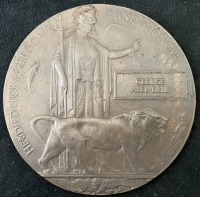
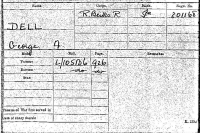

An Outstanding
“BATTLE of AMIENS”
MILITARY MEDAL,
And Later
“HINDENBURG LINE” Casualty
with
COMMEMORATIVE PLAQUE
& War & Victory Medal Pair.
To:
201168. Pte-L/Cpl GEORGE ABEL DELL.
8th Bn, Royal Berkshire Regt.
KILLED IN ACTION
20th September 1918
&
Brother’s P.O.W. Pair
 [THE MEDALS]
Military Medal (London Gazette 13th March 1919)
201168. Pte G.A. Dell, 8/Royal Berks Regt.
War & Victory Medals.
201168. L/Cpl G.A.Dell, R: Berks. R.
[THE MEDALS]
Military Medal (London Gazette 13th March 1919)
201168. Pte G.A. Dell, 8/Royal Berks Regt.
War & Victory Medals.
201168. L/Cpl G.A.Dell, R: Berks. R.


 Commemorative Plaque
GEORGE ABEL DELL
& Brother’s medals
Commemorative Plaque
GEORGE ABEL DELL
& Brother’s medals
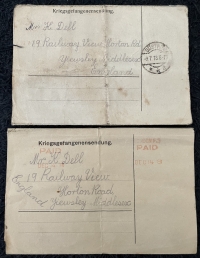
 War & Victory Medal Pair.
41448, Pte. S. DELL, Royal Berkshire Regt
With Two Important German P.O.W. Letters sent home
to Mrs Dell in Reading & official
release / arrival home notification letter
13th December 1918.
Captured in France and held at GÜSTROW, P.O.W. camp Mecklenburg, Germany.
[GEORGE ABEL DELL & SOLOMON DELL]
Both men were the Sons of Charlotte Dell of 121 Horton Road, Yiewsley, Middlesex, and the late James Dell. The address still exists.
The two brothers were named Solomon & Abel after well the known biblical characters. Solomon was a married man who lived with his wife Mrs Kathleen Dell at 19 Railway View, also in Horton Road, Yiewsley, Middlesex.
Sadly, elder brother George Abel Dell, M.M. was Killed in Action during the Battle of The Hindenburg Line on 20th September 1918.
Like so many thousands of our heroes, George’s body was lost without trace on the battlefield and he has no known grave.
His Name is Remembered with Eternal Honour on Panel 7 at Vis-en-Artois Memorial & Cemetery, Pas de Calais, France.
“LEST WE FORGET”
War & Victory Medal Pair.
41448, Pte. S. DELL, Royal Berkshire Regt
With Two Important German P.O.W. Letters sent home
to Mrs Dell in Reading & official
release / arrival home notification letter
13th December 1918.
Captured in France and held at GÜSTROW, P.O.W. camp Mecklenburg, Germany.
[GEORGE ABEL DELL & SOLOMON DELL]
Both men were the Sons of Charlotte Dell of 121 Horton Road, Yiewsley, Middlesex, and the late James Dell. The address still exists.
The two brothers were named Solomon & Abel after well the known biblical characters. Solomon was a married man who lived with his wife Mrs Kathleen Dell at 19 Railway View, also in Horton Road, Yiewsley, Middlesex.
Sadly, elder brother George Abel Dell, M.M. was Killed in Action during the Battle of The Hindenburg Line on 20th September 1918.
Like so many thousands of our heroes, George’s body was lost without trace on the battlefield and he has no known grave.
His Name is Remembered with Eternal Honour on Panel 7 at Vis-en-Artois Memorial & Cemetery, Pas de Calais, France.
“LEST WE FORGET”
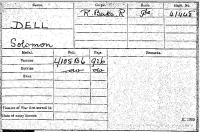 Younger brother, Solomon Dell, was held as a Prisoner of War at Güstrow. There are apparently no surviving Red Cross records for his incarceration but it’s highly probable that like many thousands of our men he was captured during March 1918 during the German Spring Offensive known as Operation Michael.
Younger brother, Solomon Dell, was held as a Prisoner of War at Güstrow. There are apparently no surviving Red Cross records for his incarceration but it’s highly probable that like many thousands of our men he was captured during March 1918 during the German Spring Offensive known as Operation Michael.
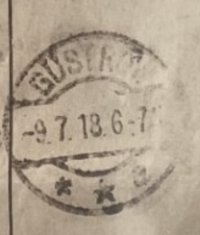 GÜSTROW.
A cathedral town in Mecklenburg with a Wartime Population of 17,800 also had an old ducal castle.
The prisoner of war camp was situated in pine-woods three miles from the town and consisted of wooden barracks holding some 25,000 men.
The camp carried over 50,000 names on its register which proves that it is was a main centre for a great number of captives during the Great War.
GÜSTROW.
A cathedral town in Mecklenburg with a Wartime Population of 17,800 also had an old ducal castle.
The prisoner of war camp was situated in pine-woods three miles from the town and consisted of wooden barracks holding some 25,000 men.
The camp carried over 50,000 names on its register which proves that it is was a main centre for a great number of captives during the Great War.
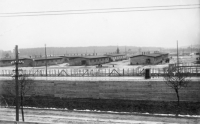 The camp lacked any infrastructure at first, which was why the living conditions were initially very hard. It was only at the beginning of 1915 that the prisoners erected at least 150 solid wooden barracks which were partially covered with roof covering tarpaulins. Other sources spoke of about 250 barracks built with the help of various Güstrower woodworkers.
Each barrack hut was subdivided in the middle and thus had two entrances. These fixed barracks were about 10 m wide and 50 m long, a smaller type was 10 m x 20 m. They are said to have housed between 50 and 100 prisoners (other sources speak of up to 250 prisoners per barracks). The minimal furnishings consisted of only the bunk beds, a few tables and benches, and two stoves for heating. … Among other features of the camp, there was a narrow-gauge railroad for transporting food and other items, which crossed the entire camp from the track of the regular railway line.
The captured soldiers arrived at the local station called Primer Burg and then had to go on foot to the camp about 2 kilometers away.
The camp lacked any infrastructure at first, which was why the living conditions were initially very hard. It was only at the beginning of 1915 that the prisoners erected at least 150 solid wooden barracks which were partially covered with roof covering tarpaulins. Other sources spoke of about 250 barracks built with the help of various Güstrower woodworkers.
Each barrack hut was subdivided in the middle and thus had two entrances. These fixed barracks were about 10 m wide and 50 m long, a smaller type was 10 m x 20 m. They are said to have housed between 50 and 100 prisoners (other sources speak of up to 250 prisoners per barracks). The minimal furnishings consisted of only the bunk beds, a few tables and benches, and two stoves for heating. … Among other features of the camp, there was a narrow-gauge railroad for transporting food and other items, which crossed the entire camp from the track of the regular railway line.
The captured soldiers arrived at the local station called Primer Burg and then had to go on foot to the camp about 2 kilometers away.
 Upon arrival in winter time a good many prisoners had to stand out in the snow for about 2 hours until they we were taken off to different huts. Each hut had a very large stove placed in the middle of the room for the purpose of warming the room, but alas there was no wood or coal with which to light a fire”
Upon arrival in winter time a good many prisoners had to stand out in the snow for about 2 hours until they we were taken off to different huts. Each hut had a very large stove placed in the middle of the room for the purpose of warming the room, but alas there was no wood or coal with which to light a fire”


 This is an exceptionally complete family grouping and worthy of inclusion in the finest collection.
PRICE ON REQUEST,
With quality part-exchanges welcome.
This is an exceptionally complete family grouping and worthy of inclusion in the finest collection.
PRICE ON REQUEST,
With quality part-exchanges welcome.
 [THE MEDALS]
Military Medal (London Gazette 13th March 1919)
201168. Pte G.A. Dell, 8/Royal Berks Regt.
War & Victory Medals.
201168. L/Cpl G.A.Dell, R: Berks. R.
[THE MEDALS]
Military Medal (London Gazette 13th March 1919)
201168. Pte G.A. Dell, 8/Royal Berks Regt.
War & Victory Medals.
201168. L/Cpl G.A.Dell, R: Berks. R.


 Commemorative Plaque
GEORGE ABEL DELL
& Brother’s medals
Commemorative Plaque
GEORGE ABEL DELL
& Brother’s medals

 War & Victory Medal Pair.
41448, Pte. S. DELL, Royal Berkshire Regt
With Two Important German P.O.W. Letters sent home
to Mrs Dell in Reading & official
release / arrival home notification letter
13th December 1918.
Captured in France and held at GÜSTROW, P.O.W. camp Mecklenburg, Germany.
[GEORGE ABEL DELL & SOLOMON DELL]
Both men were the Sons of Charlotte Dell of 121 Horton Road, Yiewsley, Middlesex, and the late James Dell. The address still exists.
The two brothers were named Solomon & Abel after well the known biblical characters. Solomon was a married man who lived with his wife Mrs Kathleen Dell at 19 Railway View, also in Horton Road, Yiewsley, Middlesex.
Sadly, elder brother George Abel Dell, M.M. was Killed in Action during the Battle of The Hindenburg Line on 20th September 1918.
Like so many thousands of our heroes, George’s body was lost without trace on the battlefield and he has no known grave.
His Name is Remembered with Eternal Honour on Panel 7 at Vis-en-Artois Memorial & Cemetery, Pas de Calais, France.
“LEST WE FORGET”
War & Victory Medal Pair.
41448, Pte. S. DELL, Royal Berkshire Regt
With Two Important German P.O.W. Letters sent home
to Mrs Dell in Reading & official
release / arrival home notification letter
13th December 1918.
Captured in France and held at GÜSTROW, P.O.W. camp Mecklenburg, Germany.
[GEORGE ABEL DELL & SOLOMON DELL]
Both men were the Sons of Charlotte Dell of 121 Horton Road, Yiewsley, Middlesex, and the late James Dell. The address still exists.
The two brothers were named Solomon & Abel after well the known biblical characters. Solomon was a married man who lived with his wife Mrs Kathleen Dell at 19 Railway View, also in Horton Road, Yiewsley, Middlesex.
Sadly, elder brother George Abel Dell, M.M. was Killed in Action during the Battle of The Hindenburg Line on 20th September 1918.
Like so many thousands of our heroes, George’s body was lost without trace on the battlefield and he has no known grave.
His Name is Remembered with Eternal Honour on Panel 7 at Vis-en-Artois Memorial & Cemetery, Pas de Calais, France.
“LEST WE FORGET”
 Younger brother, Solomon Dell, was held as a Prisoner of War at Güstrow. There are apparently no surviving Red Cross records for his incarceration but it’s highly probable that like many thousands of our men he was captured during March 1918 during the German Spring Offensive known as Operation Michael.
Younger brother, Solomon Dell, was held as a Prisoner of War at Güstrow. There are apparently no surviving Red Cross records for his incarceration but it’s highly probable that like many thousands of our men he was captured during March 1918 during the German Spring Offensive known as Operation Michael.
 GÜSTROW.
A cathedral town in Mecklenburg with a Wartime Population of 17,800 also had an old ducal castle.
The prisoner of war camp was situated in pine-woods three miles from the town and consisted of wooden barracks holding some 25,000 men.
The camp carried over 50,000 names on its register which proves that it is was a main centre for a great number of captives during the Great War.
GÜSTROW.
A cathedral town in Mecklenburg with a Wartime Population of 17,800 also had an old ducal castle.
The prisoner of war camp was situated in pine-woods three miles from the town and consisted of wooden barracks holding some 25,000 men.
The camp carried over 50,000 names on its register which proves that it is was a main centre for a great number of captives during the Great War.
 The camp lacked any infrastructure at first, which was why the living conditions were initially very hard. It was only at the beginning of 1915 that the prisoners erected at least 150 solid wooden barracks which were partially covered with roof covering tarpaulins. Other sources spoke of about 250 barracks built with the help of various Güstrower woodworkers.
Each barrack hut was subdivided in the middle and thus had two entrances. These fixed barracks were about 10 m wide and 50 m long, a smaller type was 10 m x 20 m. They are said to have housed between 50 and 100 prisoners (other sources speak of up to 250 prisoners per barracks). The minimal furnishings consisted of only the bunk beds, a few tables and benches, and two stoves for heating. … Among other features of the camp, there was a narrow-gauge railroad for transporting food and other items, which crossed the entire camp from the track of the regular railway line.
The captured soldiers arrived at the local station called Primer Burg and then had to go on foot to the camp about 2 kilometers away.
The camp lacked any infrastructure at first, which was why the living conditions were initially very hard. It was only at the beginning of 1915 that the prisoners erected at least 150 solid wooden barracks which were partially covered with roof covering tarpaulins. Other sources spoke of about 250 barracks built with the help of various Güstrower woodworkers.
Each barrack hut was subdivided in the middle and thus had two entrances. These fixed barracks were about 10 m wide and 50 m long, a smaller type was 10 m x 20 m. They are said to have housed between 50 and 100 prisoners (other sources speak of up to 250 prisoners per barracks). The minimal furnishings consisted of only the bunk beds, a few tables and benches, and two stoves for heating. … Among other features of the camp, there was a narrow-gauge railroad for transporting food and other items, which crossed the entire camp from the track of the regular railway line.
The captured soldiers arrived at the local station called Primer Burg and then had to go on foot to the camp about 2 kilometers away.
 Upon arrival in winter time a good many prisoners had to stand out in the snow for about 2 hours until they we were taken off to different huts. Each hut had a very large stove placed in the middle of the room for the purpose of warming the room, but alas there was no wood or coal with which to light a fire”
Upon arrival in winter time a good many prisoners had to stand out in the snow for about 2 hours until they we were taken off to different huts. Each hut had a very large stove placed in the middle of the room for the purpose of warming the room, but alas there was no wood or coal with which to light a fire”


 This is an exceptionally complete family grouping and worthy of inclusion in the finest collection.
PRICE ON REQUEST,
With quality part-exchanges welcome.
This is an exceptionally complete family grouping and worthy of inclusion in the finest collection.
PRICE ON REQUEST,
With quality part-exchanges welcome.